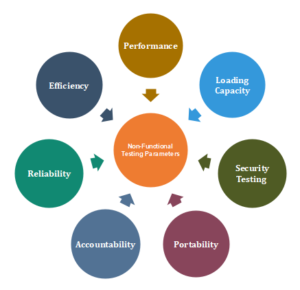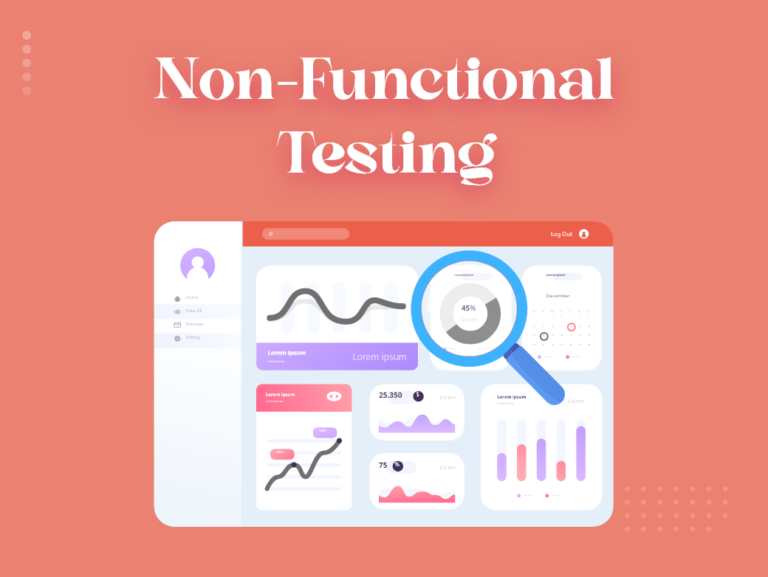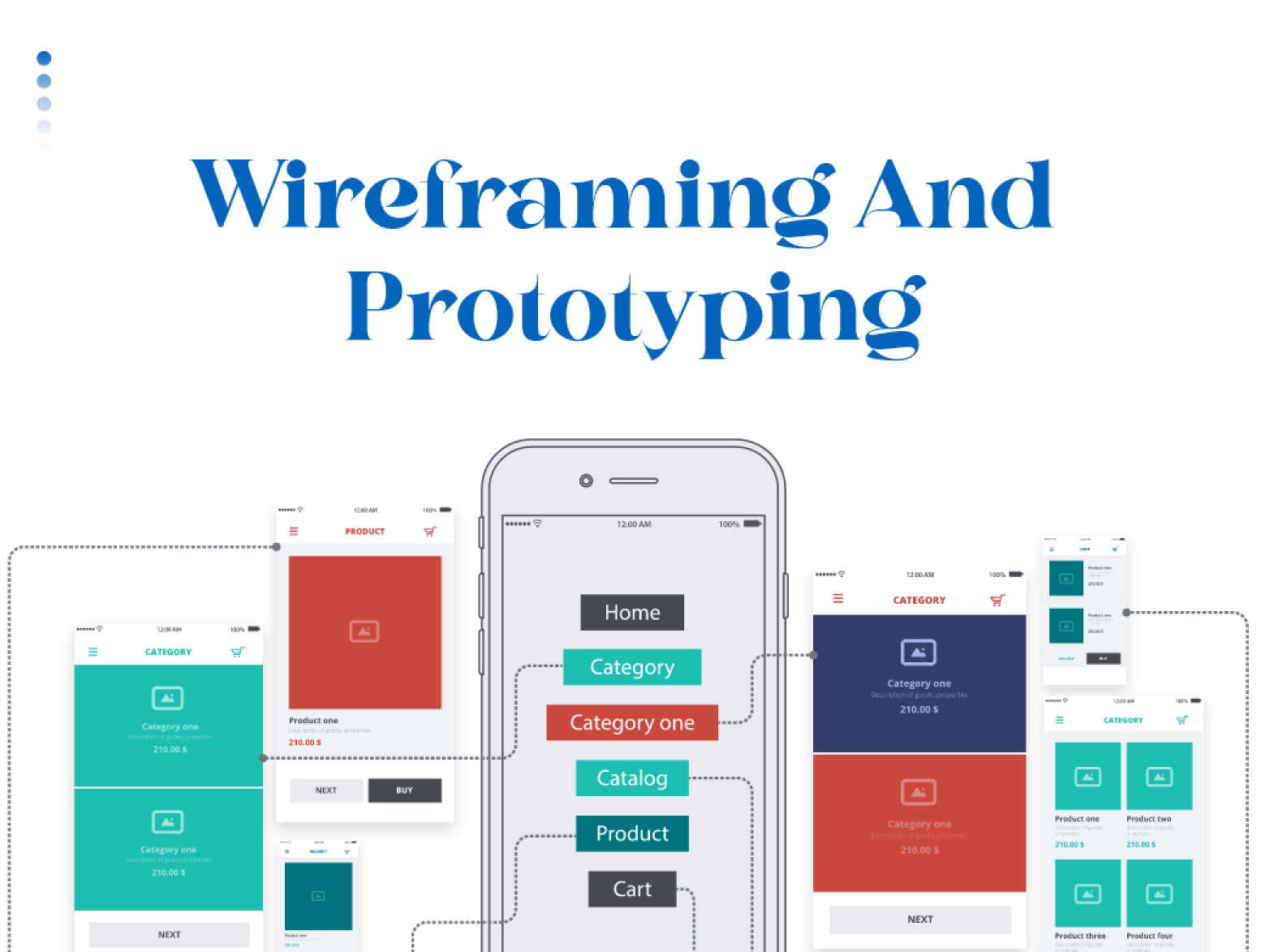Non-functional testing is a technique that evaluates a software application’s non-functional aspects or attributes. Unlike functional testing, which verifies the applicable requirements, non-functional testing assesses factors such as performance, scalability, reliability, usability, security, and other qualities that define the behavior and characteristics of the system. Its objective is to ensure the application meets the specified non-functional requirements and performs optimally under various conditions and user scenarios. Non-functional testing is essential to assess the overall quality and user experience of the software beyond its functional capabilities.

Objectives of Non-Functional Testing
There could be various objectives of non-functional testing but a few of them are explained below
- Enhancing the product’s usability, efficiency, maintainability, and portability.
- Mitigating production risks associated with non-functional aspects of the product.
- Reducing costs associated with non-functional aspects of the product.
- Optimizing the product’s installation, execution, and monitoring processes.
- Gathering and generating measurements and metrics for internal research and development.
- Improving understanding and knowledge of the product’s behavior and utilized technologies.
Characteristics of Non-Functional Testing
The characteristics of non-functional testing include the following
-
- Non-functional testing should be quantifiable and avoid subjective terms such as sound, better, good, etc.
- Specific figures may not be determined during the initial requirement phase.
- Prioritizing requirements is crucial.
- It is essential to accurately identify quality attributes in the field of Software Engineering.
Parameters of Non-Functional Testing
Parameters in non-functional testing are the inputs or variables used to specify the conditions and data values for executing test cases and evaluating the behavior of the software being tested. They enable testers to assess the software’s performance, functionality, and other aspects under different scenarios.

Some of the parameters involved in non-functional testing include the following
Security
This parameter assesses the system’s ability to protect against deliberate attacks from internal and external sources.
Reliability
It measures the software system’s capability to perform its specified functions consistently and without failures.
Survivability
This parameter guarantees the software system’s continuous functioning and ability to recover from system failures.
Availability
It determines the degree to which users can rely on the system during its operation.
Usability
This pertains to the user-friendly nature of the system, allowing users to easily learn, operate, input, and output information through system interaction.
Scalability
This term signifies the scalability of a software application in effectively accommodating growing demands by expanding its processing capacity.
Interoperability
This non-functional parameter assesses a software system’s compatibility and seamless interaction with other software systems.
Efficiency
It measures how effectively a software system handles capacity, quantity, and response time.
Flexibility
This refers to the ease with which the application can function in different hardware and software configurations.
Portability
It signifies the software’s ability to be transferred from its current hardware or software environment.
Reusability
It pertains to a portion of the software system that can be repurposed for use in another application.
Types of Non-Functional Testing
There are different types of Functional Testing and a few of them are explained below.
Performance Testing
Performance testing evaluates whether the system fulfills the non-functional requirements specified in the SRS document by examining the system’s behavior and effectiveness in terms of response time, throughput, and other factors.
Load Testing
Load testing evaluates the system’s capacity to handle increasing numbers of simultaneous users. It ensures that the system can handle the expected load without performance degradation.
Security Testing
Security testing aims to identify vulnerabilities in the software application. It involves assessing the system’s design and thinking like an attacker. By pinpointing potential attack vectors in the code, test cases can be developed.
Portability Testing
Portability testing examines the software’s ability to run smoothly on various operating systems without encountering bugs. It also tests the software’s functionality across different hardware configurations under the same operating system.
Reliability Testing
Reliability testing assumes that the software system operates flawlessly within predefined parameters. The system is run for a specific duration and through various processes. The reliability test will fail if the system encounters issues under predetermined circumstances, such as unreliable web pages or broken links.
Volume Testing
Volume testing, also known as flood testing, involves subjecting the software to a large amount of data. It evaluates the system’s performance by increasing the volume of data in the database.
Recovery Testing
Recovery testing assesses the application’s ability to rebound from crashes, hardware failures, and related incidents. This test intentionally breaks the software in various ways to assess its resilience.
Responsive Testing
Responsive testing evaluates how well a design adapts to different screen widths, providing a realistic assessment of its responsiveness. Test for responsiveness by Design Odo allows you to adjust the screen width after entering the website’s URL to observe real-time adaptations in the user interface. The objective is to ensure a smooth user experience across various devices, as technology increasingly plays a crucial role in our daily lives.
Visual Testing
Visual testing, also known as visual UI testing, addresses issues related to the correct rendering of the software’s user interface (UI) for all users. It verifies that each element on a web page appears correctly regarding shape, size, and placement. Visual testing focuses on the visible output of an application and compares it to the expected design outcomes, helping identify “visual bugs” distinct from functional bugs.
Tools for Non-Functional Testing
JMeter
JMeter is a widely utilized tool for reliability and automation testing. It is renowned for its compatibility testing capabilities and is commonly used for web and FTP applications. With its user-friendly interface, JMeter allows for accurate measurement and analysis of program performance.
Forecast
The forecast is a popular application that offers a wide range of options. It provides an easy-to-use interface, making it convenient for users to input detailed data for scalability and recovery testing. The tool ensures quick results and is cost-friendly.
LoadRunner
LoadRunner is highly regarded for its accurate results in performance testing. As a Micro Focus product, it can simulate multiple users simultaneously, providing stress test results with quality. LoadRunner offers a comprehensive performance analysis strategy.
Loadster
Loadster is a modern tool that incorporates cloud hybrid load testing techniques. It enables users to test large-scale applications and high-performance websites. Loadster excels in volume testing parameters, aiding in stability improvement.
Loadstorm
Loadstorm is a powerful tool for testing various program components. It saves time without compromising performance and offers quality functional requirements. However, it is not available for free.
Load Complete
Load Complete is a simple and efficient tool that reduces manual effort. It facilitates performance testing and localization testing. The tool generates expert reports to provide comprehensive insights.
Loadtracer
Loadtracer is an effective tool for testing program performance. It is particularly suitable for web applications, offering a wide range of functionalities. Loadtracer provides comprehensive testing capabilities at affordable costs.
Neoload
Neoload is an automation testing tool that saves time and improves productivity. It offers automation options for testing various projects, including APIs and web applications, delivering high-quality results.
vPerformer
vPerformer is a versatile tool that allows for testing web performance. It provides easy access to scale both functional and non-functional elements of a program. However, it may present challenges in a user environment.
WebLoad Professional
WebLoad Professional excels in load generation for web applications and software. It handles heavy load data and offers optimization options to enhance performance by removing unnecessary load.
Webserver Stress Tool
It is a powerful non-functional Black Box Testing tool widely available in the market. It is specifically designed for conducting HTTP tests, making it highly suitable for such scenarios. The tool operates based on specific testing requirements.
Pros of Non-Functional Testing
There are several benefits of non-functional testing and a few of them are explained below
Enhanced User Experience
Non-functional testing helps ensure that the application performs well in terms of usability, performance, and other quality attributes, resulting in a better user experience.
Increased Application Stability
By assessing factors such as reliability, availability, and recoverability, non-functional testing helps identify and address potential issues that could lead to system failures or downtime, improving the application’s overall stability.
Improved Performance
Non-functional testing techniques such as load testing and stress testing help identify performance bottlenecks, allowing for optimization and improvement of the application’s performance under different conditions.
Enhanced Security
Security testing as part of non-functional testing helps identify vulnerabilities and weaknesses in the system, enabling proactive measures to be taken to enhance the application’s security and protect sensitive data.
Compliance and Standards Adherence
Non-functional testing helps ensure that the application meets regulatory, legal, and industry-specific standards, ensuring compliance and reducing the risk of penalties or legal issues.
Cons of Non-Functional Testing
Non-functional testing also has a few drawbacks which are explained below.
Time and Resource Intensive
Non-functional testing requires additional time, effort, and resources compared to functional testing. It involves setting up test environments, executing complex test scenarios, and analyzing extensive test results.
Complex Test Design
Non-functional testing often requires designing and executing complex test scenarios to simulate real-world conditions, making it more challenging and time-consuming to create effective test cases.
Read More: Responsive Design
Expensive
Implementing non-functional testing tools, infrastructure, and expertise can incur additional costs for organizations, especially for complex testing requirements or large-scale applications.
Lack of Clear Success Criteria
Unlike functional testing, where success criteria can be more straightforward, non-functional testing often involves subjective evaluation and may lack precise pass/fail criteria, making it more challenging to determine when testing objectives are met.
Difficulty in Replicating Real-World Scenarios
Simulating real-world conditions and scenarios accurately during non-functional testing can be challenging, as it may not be possible to replicate all possible combinations of environments, user behaviors, and system loads.
Importance of Functional Testing
Non-functional testing holds great significance as it assesses the software or application’s capability to function in real-world environments. It facilitates seamless software installation, setup, and execution. Non-functional testing involves the collection and production of measurements and metrics for internal research and development purposes. Moreover, non-functional testing provides in-depth insights into the product’s behavior and the technologies employed. It plays a vital role in mitigating production risks and reducing associated costs.
Additionally, non-functional testing contributes to enhancing the product’s usability, effectiveness, maintainability, and portability. It aids in minimizing production risks and expenses related to non-functional aspects of the product.
Furthermore, non-functional testing improves installation, configuration, execution, management, and monitoring processes, while also analyzing the gathered measurements and metrics for internal study and development purposes.









